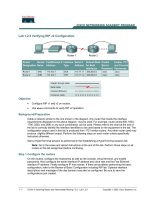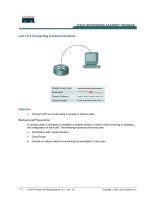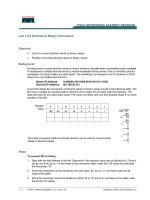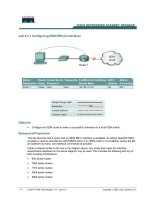Tài liệu Lab 6.2.5 Configuring Port Security pptx
Bạn đang xem bản rút gọn của tài liệu. Xem và tải ngay bản đầy đủ của tài liệu tại đây (248.49 KB, 6 trang )
Lab 6.2.5 Configuring Port Security
Objective
• Create and verify a basic switch configuration.
• Configure port security on individual FastEthernet ports.
Background / Preparation
Cable a network similar to the one in the diagram. The configuration output used in this lab is
produced from a 2950 series switch. Any other switch used may produce different output. The
following steps are intended to be executed on each switch unless specifically instructed otherwise.
Start a HyperTerminal session.
Note: Go to the erase and reload instructions at the end of this lab. Perform those steps on all
switches in this lab assignment before continuing.
Step 1 Configure the switch
Configure the hostname, access and command mode passwords, as well as the management LAN
settings. These values are shown in the chart. If problems occur while performing this configuration,
refer to the Basic Switch Configuration lab.
1 - 6 CCNA 3: Switching Basics and Intermediate Routing v 3.0 - Lab 6.2.5 Copyright 2003, Cisco Systems, Inc.
Step 2 Configure the hosts attached to the switch
a. Configure the hosts to use the same IP subnet for the address, mask, and default gateway as on
the switch.
b. There is a third host needed for this lab. It needs to be configured with the address 192.168.1.7.
The subnet mask is 255.255.255.0 and the default gateway is 192.168.1.1.
Note: Do not connect this PC to the switch yet.
Step 3 Verify connectivity
a. To verify that hosts and switch are correctly configured, ping the switch IP address from the
hosts.
b. Were the pings successful? __________________________________________________
c. If the answer is no, troubleshoot the hosts and switch configurations.
Step 4. Record the host MAC addresses
a. Determine and record the layer 2 addresses of the PC network interface cards.
If running Windows 98, check by using Start > Run > winipcfg. Click on More info.
If running Windows 2000, check by using Start > Run > cmd > ipconfig /all.
b. PC1____________________________________________________________________
c. PC2
____________________________________________________________________
Step 5 Determine what MAC addresses that the switch has learned
a. Determine what MAC addresses the switch has learned by using the show mac-address-
table command, as follows, at the privileged exec mode prompt:
ALSwitch#show mac-address-table
b. How many dynamic addresses are there?
________________________________________
c. How many total MAC addresses are there?
_______________________________________
d. Do the MAC addresses match the host MAC addresses?
_____________________________
Step 6 Determine the show MAC table options
a. Enter the following to determine the options the mac-address-table command has use the ?
option:
ALSwitch(config)#mac-address-table ?
Step 7 Setup a static MAC address
Setup a static MAC address on FastEthernet interface 0/4 as follows:
Note: Use the address that was recorded for PC4 in step 4. The MAC address 00e0.2917.1884 is
used in the example statement only.
ALSwitch(config)#mac-address-table static 00e0.2917.1884 interface
fastethernet 0/4 vlan 1
2900:
ALSwitch(config)#mac-address-table static 00e0.2917.1884
fastethernet
0/4 vlan 1
2 - 6 CCNA 3: Switching Basics and Intermediate Routing v 3.0 - Lab 6.2.5 Copyright 2003, Cisco Systems, Inc.
1900:
ALSwitch(config)#mac-address-table permanent 00e0.2917.1884 ethernet
0/4
Step 8 Verify the results
a. Enter the following to verify the mac–address table entries.
ALSwitch#show mac-address-table
b. How many total MAC addresses are there now? ___________________________________
Step 9 List port security options
a. Determine the options for setting port security on interface FastEthernet 0/4. Type port
security ? from the interface configuration prompt for FastEthernet port 0/4 as follows:
ALSwitch(config)#interface fastethernet 0/4
ALSwitch(config-if)#port security ?
Action to take for security violation
Max-mac-count maximum mac address count
<cr>
1900:
ALSwitch(config)#interface ethernet 0/4
ALSwitch(config-if)#port secure ?
max-mac-count Maximum number of addresses allowed on the port
<cr>
2950:
ALSwitch(config-if)#switchport port-security ?
aging Port-security aging commands
mac-address Secure mac address
maximum Max secure addrs
violation Security Violation Mode
<cr>
b. To allow the switchport FastEthernet 0/4 to accept only one device enter port security as
follows:
2900:
AlSwitch(config-if)#port security
1900:
ALSwitch(config-if)#port secure
Step 10 Verify the results
a. Enter the following to verify the mac –address table entries:
ALSwitch#show mac-address-table
b. How are the address types listed for the two MAC addresses?
______________________
1900:
ALSwitch#show mac-address-table security
3 - 6 CCNA 3: Switching Basics and Intermediate Routing v 3.0 - Lab 6.2.5 Copyright 2003, Cisco Systems, Inc.
2950:
ALSwitch#show port-security
Step 11 Show the running configuration file
a. Are there statements that directly reflect the security implementation in the listing of the running
configuration?
____________________________________________________________
b. What do those statements mean?
__________________________________________________________________________
Step 12 Limit the number of hosts per port
a. On interface FastEthernet 0/4 set the port security maximum MAC count to 1 as follows:
ALSwitch(config)#interface fastethernet 0/4
ALSwitch(config-if)#port security max-mac-count 1
1900:
ALSwitch(config)#interface Ethernet 0/4
ALSwitch(config-if)#port secure max-mac-count 1
2950:
ALSwitch(config-if)#switchport port-security maximum 1
b. Disconnect the PC attached to FastEthernet 0/4. Connect to the port on the PC that has been
given the IP address 192.168.1.7. This PC has not yet been attached to the switch. It may be
necessary to ping the switch address 192.168.1.2 to generate some traffic.
c. Record any observations.
___________________________________________________
__________________________________________________________________________
Step 13 Configure the port to Shut down if there is a security violation
a. It has been decided that in the event of a security violation the interface should be shut down.
Enter the following to make the port security action to shutdown:
ALSwitch(config-if)#switchport port-security violation
Shutdown
2900XL
ALSwitch(config-if)#port security action shutdown
b. What other action options are available with port security?
____________________________
c. If necessary, ping the switch address 192.168.1.2 from the PC 192.168.1.7. This PC is now
connected to interface FastEthernet 0/4. This ensures that there is traffic from the PC to the
switch.
d. Record any observations.
__________________________________________________________________________
4 - 6 CCNA 3: Switching Basics and Intermediate Routing v 3.0 - Lab 6.2.5 Copyright 2003, Cisco Systems, Inc.
__________________________________________________________________________
Step 14 Show port 0/4 configuration information
a. To see the configuration information for just FastEthernet port 0/4, type show interface
fastethernet 0/4, as follows, at the privileged exec mode prompt:
ALSwitch#show interface fastethernet 0/4
b. What is the state of this interface?
FastEthernet0/4 is
_________________________, line protocol is ____________________
1900:
ALSwitch#show interface ethernet 0/4
What is the state of this interface?
Ethernet 0/4 is ______________________, line protocol is ___________
Step 15 Reactivate the port
a. How would port 0/4 be reactivated? It is done by using the no shutdown command.
b. Try reactivating this port a few times by switching between the original port 0/4 host and the new
one. Plug in the original host, type the no shutdown command on the interface and ping using
the DOS window. The ping will have to be repeated multiple times or use the ping
192.168.1.2 –n 200 command. This will set the number of ping packets to 200 instead of 4.
Then switch hosts and try again.
Step 16 Exit the switch
Type exit, as follows, to leave the switch welcome screen:
Switch#exit
Once the steps are completed, logoff, by typing exit, and turn all the devices off. Then remove and
store the cables and adapter.
5 - 6 CCNA 3: Switching Basics and Intermediate Routing v 3.0 - Lab 6.2.5 Copyright 2003, Cisco Systems, Inc.
Erasing and reloading the Switch
Enter into the privileged exec mode by typing enable.
If prompted for a password, enter class (if that does not work, ask the instructor).
Switch>enable
Switch#delete flash:vlan.dat
Delete filename [vlan.dat]?[enter]
Delete flash:vlan.dat? [confirm] [enter]
If there was no VLAN file, this message is displayed.
%Error deleting flash:vlan.dat (No such file or directory)
At the privileged exec mode enter the command erase startup-config.
Switch#erase startup-config
The responding line prompt will be:
Erasing the nvram filesystem will remove all files! Continue? [confirm]
Press Enter to confirm.
The response should be:
Erase of nvram: complete
Now at the privileged exec mode enter the command reload.
Switch(config)#reload
The responding line prompt will be:
System configuration has been modified. Save? [yes/no]:
Type n and then Enter.
The responding line prompt will be:
Proceed with reload? [confirm] [Enter]
In the first line of the response will be:
Reload requested by console.
After the Switch has reloaded the line prompt will be:
Would you like to enter the initial configuration dialog? [yes/no]:
Type n and then Enter.
The responding line prompt will be:
Press RETURN to get started! [Enter]
6 - 6 CCNA 3: Switching Basics and Intermediate Routing v 3.0 - Lab 6.2.5 Copyright 2003, Cisco Systems, Inc.









